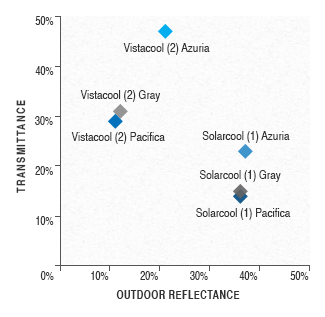Comparing Vistacool, Solarcool
Posted in Glass Products, Mar. 7, 2013
Vistacool is a new class of color-enriched reflective glazings, with higher visible light transmittance. See how it compares to Solarcool.
Aesthetics and Performance
 Aesthetic and performance differences between Vistacool and Solarcool, a traditional reflective glass are best illustrated in the cart on the right. Comparing the products in a 1-inch insulating glass unit, Vistacool glazings transmit more visible light (between 29% and 47%) than Solarcool. This results in higher levels of natural daylighting, which is preferred in sustainable design trends. First-surface Solarcool glazings have a higher outdoor reflectance (about 36%) that gives the glass its mirror-like appearance, while Vistacool has a more understated reflective aesthetic (between 11% and 21%).
Aesthetic and performance differences between Vistacool and Solarcool, a traditional reflective glass are best illustrated in the cart on the right. Comparing the products in a 1-inch insulating glass unit, Vistacool glazings transmit more visible light (between 29% and 47%) than Solarcool. This results in higher levels of natural daylighting, which is preferred in sustainable design trends. First-surface Solarcool glazings have a higher outdoor reflectance (about 36%) that gives the glass its mirror-like appearance, while Vistacool has a more understated reflective aesthetic (between 11% and 21%).
Surface Considerations
Traditional Solarcool is a durable coating that can be specified for first-surface (outboard) and second-surface (inboard) applications. Vistacool can only be specified for second-surface applications. Because surface application determines some aesthetic and performance characteristics in reflective glazings, it is important to consider the differences.
First surface reflective coatings reflect more visible light, resulting in a dominant metallic aesthetic seen from the outside, improved solar performance and clearer interior views due to lower interior reflectance. Second-surface coatings reflect less visible light, which produces a deeper color without muting the tinted substrate.
In a one-inch insulating glass unit, Solarcool (1) Green + Clear achieves a 0.28 solar heat gain coefficient. With the Solarcool coating applied to the second surface (inboard), the SHGC is 0.31. Second-surface Solarcool also creates a warmer reflective aesthetic.

